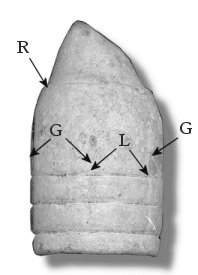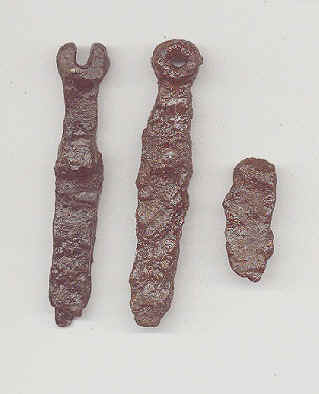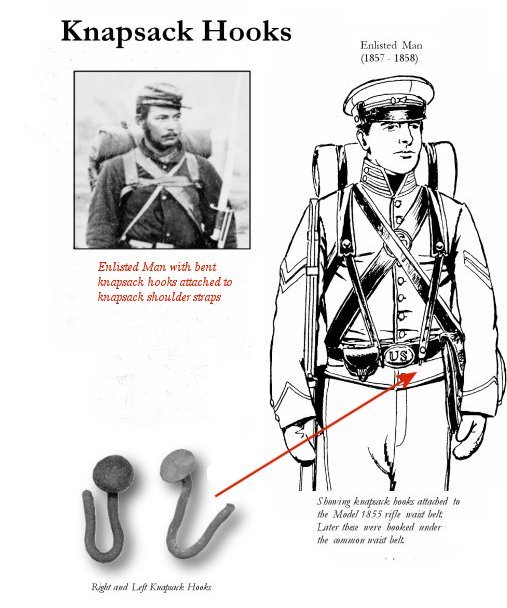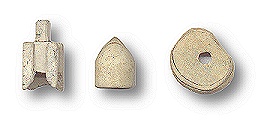
"We have met the Enemy and they are ours." That's what I say to my partner when we have completed a lengthy research problem which usually starts out simply. Here was our simple problem: Dealing with an 1861 campsite based upon the Official Records of activity in the area. Do all the relics found in the campsite confirm that date? This illustrates the process we used to date a campsite.
The extent of the relic field of the campsite indicated that 2 to 4 companies of Federal troops (found General Service buttons (authorized by GO1 of January 1854) and Kepi letters "B" and "C" (authorized in 1851)) were camped in our area.
For dating a camp, the most obvious thing to use is dropped coins with
the "youngest" or "most recent" date to identify the date or
approximate date of the camp. Three coins were found that were pre-war and Civil
war dated:1840 and 1861. Ok, that makes sense. We found only
.69 caliber Miniť drops within the relic field and about a mile away we found a
practice range in which the .69s have 3 rifling barrel grooves on the shot
bullets. This meant that we potentially deal with 4 possible weapons: the Model
1816; Model 1822; Model 1840 and the Model 1842.

Typical .69 caliber bullet found at a rifle practice area near the campsite. The nose of the bullet shows the characteristic bend of a ricochet impact upon hitting the earth near the target.
The deep ram mark "R" on the bullet nose indicates over-ramming by probable "green" troops. Three symmetrical broad barrel rifling grooves "G" on sides of bullet and "L" are marks of rifling lands.
Conversion of early firearms to new ignition systems
The US adopted the percussion ignition system for its weapons in 1841-1842 and in 1848 began converting many of its weapons. The method selected was the cone-in-barrel method. Hundreds of thousands of flintlocks (particularly the Model 1822 and Model 1840) were converted to this ignition system and rifled from 1848 to 1858. With the adoption of the "Minie ball" in 1855, the era of smoothbore muskets and the cone-in-barrel ignition system ended.
By 1859 it was determined that the prior alteration to percussion had too weakened the barrels of the older muskets (Model 1816 and 1822) to withstand the increased pressure generated by the tighter seal of the newly adopted rifle projectile. The older converted weapons and unconverted flintlocks were auctioned off in the pre-war usually to the Southern states who were eager for any firearms.
At the beginning of the Civil War, many states were issued either percussion rifled muskets (Model 1840 to Model 1842) or smoothbore muskets going all the way back to Model 1816. After several unsuccessful attempts to come up with a new ignition system, the Maynard Percussion system was selected and Remington was selected to build Maynard Percussion lock and new strengthened breech pieces to convert Model 1842s. Rifling and conversion of the smoothbore Model 1842 continued at the arsenals as well as at Remington. All rifling of these early conversion consisted of 3 broad barrel grooves which is consistent with our shot finds for the area. The Maynard percussion system really began with the later .58 caliber Model 1855.

Musket Wrenches found at Campsite (Left Photo): Open-ended single blade M1855 and in the Colt Special Model of 1861 and later incorporated in M1863 Rifle Musket (left) Closed-ended single blade 1842 (Center) and fragment from wrench blade (right).
We found an open-ended single blade rifle musket wrench that was first issued in 1855 and a close-end single blade issued in 1842 and given the .69 Minies, we feel that we were dealing with converted Model 1840 and/or 1842 Rifled Muskets. Other relics which point to the 1855 date were several knapsack hooks which were made part of the US Regulation knapsack in 1855.

Hooks on the breast straps of the 1855 US Regulation knapsack were fitted to attach to the waist belt but were often bent to attach to knapsack shoulder strap rivets.
That brings us to the last datable items from the camp. The bayonet scabbard patterns. We recently found two very good internet sites to partially help us: the C&D Jarnagin Co. has an excellent gallery with identified scabbards and Arms2Armor.com which is run by C. Alan Russell also has excellent information on bayonets from many countries.
From the Jarnagin site, we learned that all pre-1863 US scabbard tips were attached to the leather of the scabbard by 2 brass nails and, that after 1863, 4 brass nails were symmetrically placed around the tip. We found the remains of four scabbard tips in our camp and all had only 2 nail holes. This pre-1863 dates of these tips agrees with all of the other dates for the camp.
Alan Russell suggests that only two basic socket bayonet designs were used during the War and from 1855 to about 1861 when muskets were converted they were given a new bayonet (US Model 1816 Replacement or "Conversion" Bayonet) designed to fit the various manufactured .69 caliber flintlock muskets converted to percussion. His description of the scabbard tips matches the ones shown below.

Scabbard tips found at our campsite showing only two
attachment holes making them pre-1863.
Note: Rib at top of finial (Tips
"A" and "B") were is not present 1851 or later
scabbards according to Jarnagin
Finial "C" does not have a rib and
possible matches the 1842 Pattern (See below).
This suggests that "A" and
"B" may predate Finial "C".

We were able to find a Model 1842 Scabbard on the internet and its finial compares favorably with Finial "C" in the above. We speculate that scabbard tips "A" and "B" are older and may represent the Model 1840 scabbard or they are from another maker of the Model 1842 scabbard. Has anyone ever found a scabbard tip like "A" or "B" that they can get a date from?
Conclusion
We have not found any relics to dispute the late 1861 date for this camp. Indeed one of the dropped coins is right on that date. We are dealing with a Regular Infantry (2 to 4 companies based upon relic field dimensions -"B" and "C" Kepi Letters) in a classic camp pattern even down to the camp guard location. For weapons they had, Model 1842 and perhaps Model 1840 rifle muskets converted to percussion and rifled about 1855 (Bullets and Nipple Wrenches).
Based upon the reasonable number of what we call "Boredom Indicators" (carved bullets, lead gaming pieces and melted lead) we conclude that they were in camp for a reasonable amount of time.

Boredom Indicators: Some of Chess and Checker pieces carved from .69 bullets found at the campsite. Other indicators indicating a long occupation include carved bullet fragments.
Had we found datable relics of a significantly different age, then we would conclude a second occupancy of the site.
Hope this helps.